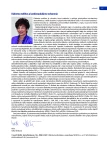Rehabilitation in diabetic patients
Authors:
Peter Takáč; Anna Kubincová
Authors‘ workplace:
Klinika fyziatrie, balneológie a liečebnej rehabilitácie, LF UPJŠ a UN LP, Košice
Published in:
Forum Diab 2017; 6(3): 149-153
Category:
Topic
Overview
Diabetes mellitus is a chronic disease with a serious impact on the whole body, whose treatment requires comprehensive measures including rehabilitation medicine. Basic factors determining the need for rehabilitation of diabetic patients in particular include disability in relation to the underlying disease, complications and comorbidities related to diabetes, the need to undertake preventive measures, reduction of risk factors, change of lifestyle, improvement of quality of life, integration into society as well as economic benefit. The study presents the current views on indications for and targets of rehabilitation. We highlight the benefits of different kinds of kinesiotherapy in accordance with the present international recommendations. We also include an overview of a wide range of rehabilitation practices which may be beneficial in relation to a specific clinical state of the diabetic patient.
Key words:
disability, exercise therapy, indications of rehabilitation, neurophysiological methods, physical therapy
Sources
1. [Australian Institute of Health and Welfare]. Diabetes and disability: impairments, activity limitations, participation restrictions and comorbidities. Diabetes series No 20, Cat. no. CVD 63. AIHW: Canberra 2013; ISBN 978–1-74249–499–9.
2. Rick O, Stachow R et al. Klinikleitfaden Medizinische Rehabilitation. Urban & Fischer: München 2011. ISBN 978–3-437–22406–5.
3. [World Health Organization Regional Office for Europe]. Physical activity strategy for the WHO European Region 2016–2025. WHO 2016. ISBN 978 92 890 5147 7. Dostupné z WWW: <http://www.euro.who.int/__data/assets/pdf_file/0014/311360/Physical-activity-strategy-2016–2025.pdf?ua=1>.
4. [American Diabetes Association]. Standards of Medical Care in Diabetes – 2017: Summary of Revisions. 4. Lifestyle Management. Diabetes Care 2017; 40(Suppl 1): S33-S43. Dostupné z DOI: <https://doi.org/10.2337/dc17-S007>.
5. Rybka J. Diabetes mellitus – komplikace a přidružená onemocnění: diagnostické a léčebné postupy. Grada: Praha 2007. ISBN 978–80–247–1671–8.
6. Garber CE, Blissmer B, Deschenes MR et al. [American College of Sports Medicine]. American College of Sports Medicine position stand. Quantity and quality of exercise for developing and maintaining cardiorespiratory, musculoskeletal, and neuromotor fitness in apparently healthy adults: guidance for prescribing exercise. Med Sci Sports Exerc 2011; 43(7): 1334–1359. Dostupné z DOI: <http://dx.doi.org/10.1249/MSS.0b013e318213fefb>.
7. Sluik D, Buijsse B, Muckelbauer R et al. Physical activity and mortality in individuals with diabetes mellitus: a prospective study and meta-analysis. Arch Intern Med 2012; 172(17): 1285–1295. Dostupné z DOI: <http://dx.doi.org/10.1001/archinternmed.2012.3130>.
8. Colberg SR, Sigal RJ, Yardley JE et al. Physical Activity/Exercise and Diabetes: A Position Statement of the American Diabetes Association. Diabetes Care 2016; 39(11): 2065–2079. Dostupné z DOI: <http://dx.doi.org/10.2337/dc16–1728>.
Labels
Diabetology Endocrinology Internal medicineArticle was published in
Forum Diabetologicum

2017 Issue 3
Most read in this issue
- Rehabilitation in diabetic patients
- Management of cardiovascular risk in the light of current recommendations
- Diabetes mellitus and cerebrovascular diseases
- Fourier Study: Has it brought little or a lot of good? Or has it just failed to reach exaggerated expectations?
